Long time resident Ken Brown and recent resident Nashira Reisch take you on a thirty minute tour of Cascadia Commons.
Author Archives: David Chilstrom
R.I.P CHIP
2017—2024



t is with a heavy heart that I announce that our beloved friend and servant CHIP (Common House Intrepid Printer) has shuffled off the mortal coil of toil and turmoil, that is the common lot of the public printer. CHIP churned out bank statements, financial reports, reimbursement forms, and more without complaint. Wine labels, Consensus Cards, any number of full color flyers and brochures, web pages, emails all were delivered faultlessly from his trusty paper tray.
It’s the end of a printer error at Cascadia, so join me in a toast to CHIP. 🍷
I see you’ve met Cynthia
Is it time to retire our current card system?

Executive summary
For you busy executives 😎.
- Summary
- An explanation of the current card system used in Cascadia HOA meetings.
- Virtues of the present card system.
- Pitfalls of the six card system.
- A simpler three card solution.
- Conclusion.
Now that we are tentatively beginning to hold our community meetings in person again, after two years of virtual presence via Zoom technology, some have suggested that we resume use of the card system in HOA meetings. This post will explain the current system and propose a simpler one that is easier to learn and use.
Given that we have five households that have not had to grapple with learning to use the current six card system, this is an opportune time to consider a change. As this system was, according to my review of the record of HOA consensus, never agreed upon by the HOA formally, it does not have to be revoked or modified by consensus.
The Current Cascadia Card System
In the procedural context, colored cards are used by the meeting facilitator to determine the “stacking” order for the comment queue. In the decision making context they are used primarily to give a visual indication of who supports the decision, who is standing aside, and who is blocking consensus.
When blocking consensus, we expect you to support your position by pointing out where the proposal under consideration is in violation of our mission or guiding principles.
The following is the order of precedence when the facilitator is calling on members to comment:
Red > Purple > Orange > Yellow > Green > Blue.
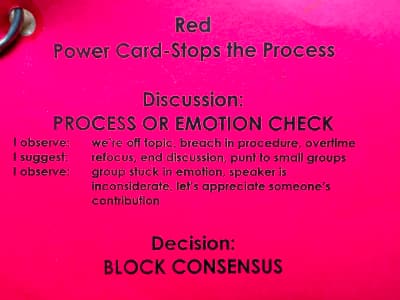
The Red Card
Discussion – No, this card does not mean you are really, really mad. That’s what the purple card is for. In discussion, it’s used to state an observation relative to a breach of procedure, going overtime, off topic, stuck in emotion, etc. Also, to suggest refocus or punt to a smaller group.
Decision – When testing for consensus, holding up a red card signifies an intention to block the proposal being considered.
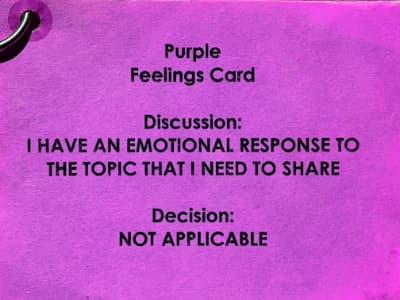
The Purple Card
Discussion – That’s right, let us know what you’re really feeling .
🤬🤪🥰😱🥳😩
Decision – Sorry, expression of feelings during the test for consensus is strongly discouraged 😉🧐.
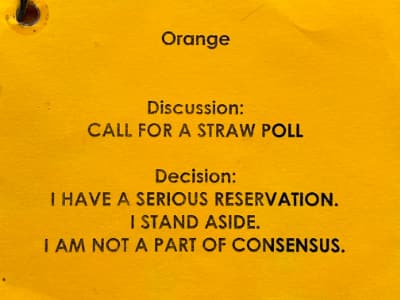
The Orange Card
Discussion – This is used to call for a straw poll. The purpose of a straw poll is to see where the members currently stand with respect to the proposal being discussed.
Decision – In the test for consensus, this card is used to stand aside or abstain from the decision.

The Yellow Card
Discussion – Got a question during discussion? This is the card for you.
Decision – If you need information or clarification during the test for consensus, then we’ve really fouled up somewhere.

The Green Card
Discussion – Yes, please tell us what you know about the matter that is boggling us!
Decision – This is your opportunity to let us know how meh or slightly peeved you are about the proposal up for decision.
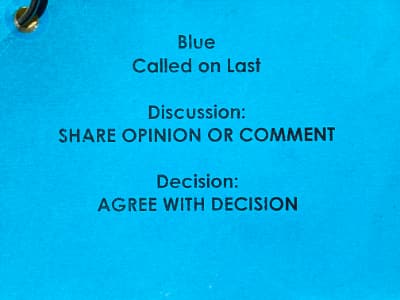
The Blue Card
Discussion – Speak your piece, hopefully something to do with the topic at hand.
Decision – This means you are on board, full steam ahead! 🛳
Why use cards at all?
Colored cards give a visual indicator to the meeting facilitator as to how to “stack” participants in the comment queue. In the test for consensus, the facilitator can quickly spot blocks or stand asides and ensure that their objections are noted in the minutes and decide with the group what the next steps should be.
Virtues of the six card system
For savvy users of the six card system, the spectrum of choices available while commenting and deciding is a boon. Some people, for instance, like using the green card in the test for consensus to indicate that they are granting consent with minor caveats.
Pitfalls of the six card system
As a meeting facilitator, I notice even long time members fumbling in search of the appropriate card. It took me a year or two to become comfortable using the cards when I first came to Cascadia. I like to think I’m not stupid, but I sure felt that way in the early meetings.
A simpler card system

The flow in discussion and the test for consensus tends to fall in three different modes:
- stop the discussion or decision
- pause the discussion or decision
- go ahead with the discussion or decision.
Sound familiar? The three card system uses the familiar stoplight metaphor of go, slow, stop; which makes for an easier to remember and shorter set of choices for the meeting attendee to grasp.
The following is an excerpt from: The Consensus Decision Process in Cohousing
Using Colored Cards to Achieve Consensus
Groups have successfully used the following system of colored cards to facilitate the consensus process. There are two contexts in which to use the cards: Procedural and Decision Making.
Procedural uses occur during preliminary discussions of an issue. Participants hold up a card before speaking. The facilitator recognizes them in the following order:
(1) Red (2) Yellow (3) Green
In the procedural context, the cards have the following meanings
- Red means “Stop the Process” (time out) and indicates a breach in agreed upon procedures. Examples include; discussing topics not on the agenda, going overtime, and suggesting that a member of the group is being inconsiderate of the group process. It can also be used when a member feels uncomfortable with the way that the process is proceeding or if they believe that a break would be appropriate. The red card may be raised at any time during discussion.1
- Yellow indicates a member’s ability to clarify some part of the discussion. 2
- Green indicates a member’s desire to make a comment or ask a question.
More than one card may be raised at a time by a single member, but the order of priority listed above is still observed. When there is more than one card of the same color raised, the facilitator ensures that the individuals are heard in the order that the cards have been raised
In the decision-making context the cards have the following meanings
- Green indicates agreement with the proposal under discussion.
- Yellow indicates that the member has reservations but is unwilling to block group consensus because of those reservations.3
- Red indicates the member’s opposition to the proposal at hand and their willingness to block group consensus because of that opposition. When a member/or members use a red card, it becomes his or her responsibility to work with the proposing committee to come up with a solution that will work for everyone.
It is incumbent upon group members to use red cards judiciously within the procedural context, remembering that green cards permit questions and comments. Similarly, in the decision-making context, members should be conscious of the seriousness of blocking consensus and use the red cards only for principled objections. However, when a member strongly believes that the fundamental interests of the group are not being served by a particular decision, the red card should be used as a vote of conscience, even if unpopular.4
Modifications of the above system for Cascadia use
- Calling for a straw poll currently uses the orange card. Since calling for a straw poll is meant to stop the flow of discussion, I believe that the red card can do double duty during discussion.
- We currently use the yellow card for questions. In addition to dealing with clarifying questions before discussion and test for consensus, I believe questions that arise during discussion can be piggybacked on the yellow card, along with clarifications and more information.
- The orange card does not serve to block consensus, therefore the yellow card can be appropriately used for this. Yellow card holders in consensus should have their concerns noted in the meeting minutes.
- Refer to the guiding principles when using the red card in consensus.
Think of the stoplight metaphor when using the three card system. Do I need to pause the discussion with a yellow card to ask a question or provide information? Should I stop the discussion to note a breach of procedure or call for a straw poll?
Conclusion
The Magical Number Seven, Plus or Minus Two
An oft cited paper in psychology The Magical Number Seven, Plus or Minus Two: Some Limits on Our Capacity for Processing Information sets the number seven as the ideal maximum number of variables for our minds to easily juggle. Our current system has a total of 11 meanings for the colored cards, and few members can use them without frequent reference to the explanations printed on the cards. Since we only use the cards for HOA meetings, and some cards get seldom used, it is very easy to forget the appropriate color for the task at hand. The three card system has a total of six meanings, three each for discussion and the test for consensus.
The reason for using cards is to facilitate an easy flow during our meetings. If the cards are acting as a source of confusion or frustration, they are failing in that function.
Missing from the three card system is the purple card for feelings. The truth is that strong feelings are often present throughout discussion and the test for consensus. Rather than corralling our emotions into one segment of discussion, we should refine our perceptions to notice when a member is struggling or in reaction and make a point of acknowledging what we perceive they are feeling and confirm that we heard what they were saying.
Is 86% Consensus Good Enough?

On the second Sunday of each month at Cascadia Commons; vegans, vegetarians, pescatarians, and omnivores gather together in the Common House to have HAM—a Homeowners Association Meeting.
Like many co-housing communities, Cascadia Commons is governed by consensus, or rather the HOA is. Up until 2013, residents who were not members of the HOA (renters, housemates) could liberally participate in consensus with the following restrictions:
Consensus/participation rights of tenants will exclude condo doc amendments, leases, easements, or matters with significant implications for HOA and/or homeowner finance and property values…2
Agreed by consensus May 13, 2001
This above restriction had the caveat that it would only be invoked when “the process gets bogged down or tenants hold the only red cards.”
Then, in September of 2012, one of the renters in the unit downstairs from us lit a firecracker in the mailing list with the following:
Is it true that Renters are no longer capable of speaking during meetings (HOA)?3
Email Thread Regarding Renter Participation in Cascadia HOA meetings
A lively dialog ensued on the list, meetings of various committees were held over the following months, with the upshot being that the former agreement allowing renter participation in consensus was rescinded. Going forward, renters and other resident non-homeowners were no longer permitted to participate in consensus decisions in the HAM:
Renters and non-owner residents may participate in discussion but not participate in a test for consensus or vote.4
Agreed by consensus Feb 10, 2013
There is a trend in Cohousing to lose sight of the founder’s vision and ideals and slowly slouch towards becoming just another condominium association.5 Looking back, I think we missed an opportunity to creatively retain the community consensus while still satisfying the legal restrictions that bind Condominium boards in our state. Let us rend unto Caesar what is Caesar’s and not one jot or tittle more.
At least 14% of current Cascadia adult residents are ineligible to participate in consensus, due to not being named on the title of their place of residence. Perhaps we need some RAMs (Resident Association Meetings) to serve alongside our HAMs.
- 86% figure derived from at least 4 adult resident non-owners ineligible to participate in consensus.
- Agreed by consensus May 13, 2001
Consensus/participation rights of tenants will exclude condo doc amendments, leases, easements, or matters with significant implications for HOA and/or homeowner finance and property values. Implementation: meeting facilitators can invite anyone to participate in any discussion. This policy is for times when the process gets bogged down or tenants hold the only red cards. - Email Thread Regarding Renter Participation in Cascadia HOA meetings
- Agreed by consensus Feb 10, 2013
It is proposed that all HOA meetings will continue to be referred to as “HOA Meetings” but will be conducted in a open meeting format whereby renters and non-owner residents may attend and participate in discussion at the discretion of the facilitator in the same manner available to unit owners. Renters and non-owner residents may participate in discussion but not participate in a test for consensus or vote. - The 100,000-mile Community Tune Up CoHousing.org blog July 17, 2015
CCA (Not Tribal) Knowledge

In the interest of communal harmony, the language and imagery of the original article have been altered. The stricken text remains, so that the original sin of the author is laid bare to the reader. If any Packers’ fans are offended by the replacement image for this article, please feel free to express your sentiments in the comments section. – ed
Imagine that you are standing at the front door of the Common House at 6am, with an urgent need to enter the building and the keypad lock isn’t responding. Do you know where the Common House key can be found? A light isn’t working in the south side parking lot. Whom should you inform and how? You’re not on the current meal rotation. Is it OK to take leftovers from the Common House fridge? The answers to these and a multitude of other questions are part of the tribal Cascadia Commons acquired (hereafter CCA) knowledge accumulated here over the past twenty years.

A small fraction of that tribal CCA knowledge is contained in the members manual, most of it resides in someone’s noggin, the rest can be found on a paper calendar, or document, by searching the mailing list message archive, or Google Drive.
Because we don’t know what we don’t know, it’s often difficult to formulate the questions we should ask. It would be helpful to have a proper owner’s manual for Cascadia Commons.
I’ve spent a week and a half, putting some of our tribal CCA knowledge into a Groups.io wiki. It’s really cool. And, the exercise of organizing and understanding the fraction of our collective wisdom available in print and on Google Drive has been personally illuminating. Particularly, I’ve become aware of the gaps where we have not formalized unwritten codes of conduct and tradition. We are very dependent on the knowledge that is often locked away in the brains of our fellow residents. Thank heavens for the mailing list. Otherwise we’d be constantly knocking on doors which, in this particular era, is probably something we should try to minimize.
While my first post on this topic focused on the nifty messaging features of Groups.io, I’m equally impressed with the Wiki and easy access to Google Drive files. Having a single site, where all of our digitized knowledge can be managed and accessed, is much less stressful than navigating between several different platforms to find what you are looking for.
A No-Brainer Proposal


I’ve been thinking for a while about our Cascadia Commons mailing list which is, by today’s standards of social media and online group networking tools, truly archaic. Even for a mailing list platform Google Groups is bare bones basic. It hasn’t changed much since its inception.
Groups.io has a take on dealing with some of the limitations in traditional mailing list platforms. At its basic level it works just like every other mailing list. Messages posted to the list show up in your inbox. What’s cool is that you decide which messages are sent to your inbox by filtering messages with hashtags you designate. So, if you don’t want email on topics such as #pandemic, #dirtyjoke, #dumptrump; you can mute them and manage the inflow from the list to your inbox as you wish. Handy links appear in the footer of each message letting you mute further messages on the thread or all messages with that hashtag in the future.

There’s lots more great stuff on the server side too. You can create an album of vacation pix and post a link to it, or use a single album to store all photos that you share in messages on the site. And, like Google Groups, you can also have a web only account. Unlike Google Groups, the web features are so good that you will actually want to use it.
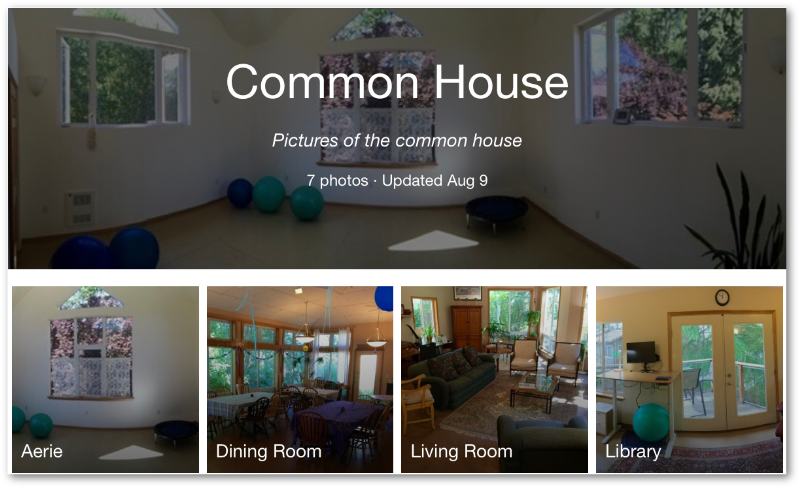
Requests for help can be mildly problematic as people often respond privately and we don’t know if the issue was resolved or not. The chat feature handles these scenarios beautifully. I send out my chat message to the list: “Need a ride to the airport Sunday AM.” In the footer of the message is a link to the online chat. Anyone can check the chat to see the status of the issue. No need for any more messages to the list on the topic.
There’s an integrated calendar that will send notices of upcoming birthdays and events to the list. Yes, you can mute those too if you don’t wish to receive calendar reminders. And, it has a simple poll feature for questions like: “What night would you like to watch my “Best of Ernest Borginine” film marathon:
- Monday
- Wednesday
- Friday
- Not in a million years
While it might not fully replace Google Drive because of the 1GB file limit on free accounts, the essential files can be stored on Groups.io and even links to Google Drive files and folders as well. Oh, and a feature that I appreciate, the list can subscribe to The Cascadian blog feed, sending notices of new articles as they are posted.
Finally, as the storehouse of Cascadia Commons tribal knowledge, there’s a wiki. Who knew we needed a wiki? Want to reference the Pet Policy and read comments on outstanding issues? It’s in the wiki. Confused for the umpteenth time about which plastic lids go where in the recycling, just check the wiki page. As a repository for communal knowledge, wikis are the jam.
You’re probably asking yourself now “How can I behold this eighth wonder of the world and see the great pyramids of email for myself?” You can subscribe to the list on it’s Groups.io home page and you’ll be all set for when and if we migrate from Google Groups. I think it’s a no-brainer 🤓.
Look for an official proposal and demo at the next HOA meeting.
Hat Contest
For Sue’s retirement party a hat contest was held. Here are the entrants.
Over the Horizon
For Sue on the occasion of her retirement.

What lies in store for you,
For any of us,
in these uncertain times
When the world that we knew
is falling away.
We’re all taking leave from routine
Retiring from our usual pursuits
Adapting ourselves,
our behaviors,
our thinking,
to a stricken world
unseen in a century.
On this turbulent tide of change
Your little boat slips out of the workaday world
bobbing along with a motley fleet of vessels
As we navigate through the chop and fog
To a new world across the sea.
Get Your Hat On

As part of Sue’s upcoming virtual retirement party, she is hosting a hat making contest and asking people to submit a photo of their entry. While I’m usually not keen on costumes and dress up, I decided to go for the gold in submitting my Carmen Miranda inspired entry.
Recent Comments